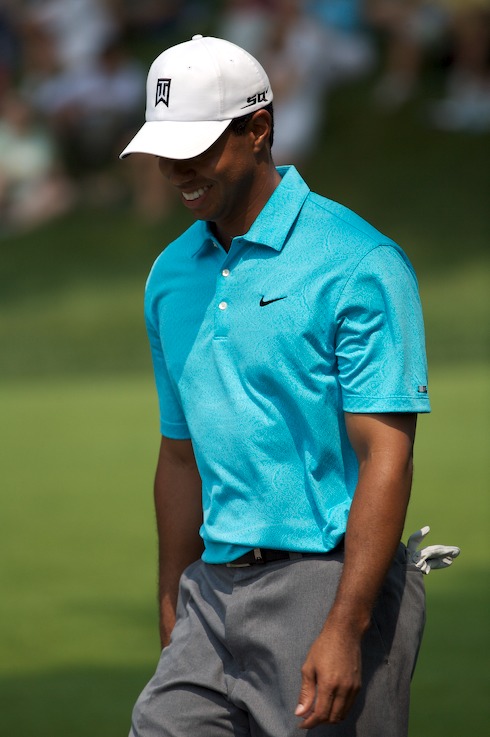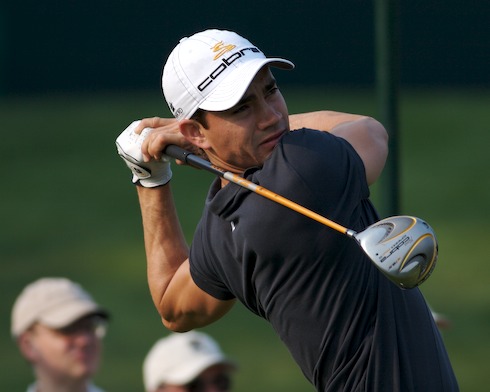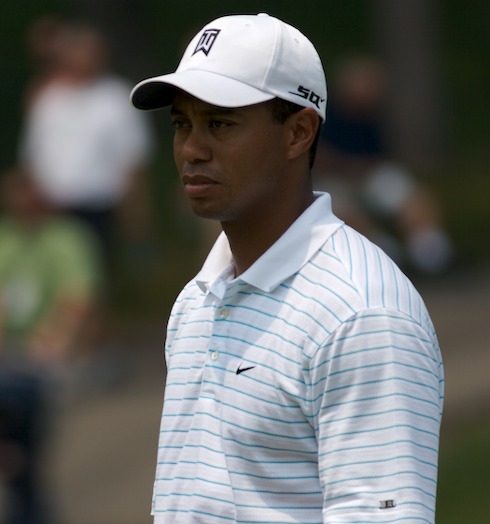 Well, Tiger’s back (though he’ll be taking the weekend off). I, for one, am happy that he’s back. Sure it was interesting to see more press about some of the other guys on Tour, but they just don’t have the same impact that Tiger does, on Tour and beyond.
Well, Tiger’s back (though he’ll be taking the weekend off). I, for one, am happy that he’s back. Sure it was interesting to see more press about some of the other guys on Tour, but they just don’t have the same impact that Tiger does, on Tour and beyond.
We’ve experienced a beehive of buzz (or maybe several) in the week since Tiger announced that he would participate in the WGC-Accenture Match Play. That Samuel L. Jackson spot on Golf Channel was out less than 12 hours after the announcement. Nike wasn’t far behind with its new “The Good Life” where five pros live it up until you-know-who walks back into the locker room. The marketing machine runs at full speed when Tiger is involved.
 Tiger haters will rail about all the hype, and rejoice in another Tiger-free weekend (although I suspect there will be plenty of replays of Tiger’s Wednesday and Thursday shots to keep them from fully enjoying themselves).
Tiger haters will rail about all the hype, and rejoice in another Tiger-free weekend (although I suspect there will be plenty of replays of Tiger’s Wednesday and Thursday shots to keep them from fully enjoying themselves).
The build up to Wednesday’s round was as big as any we’ve seen in golf since possibly Annika’s first round at Colonial. Too much? Maybe. But the last time the guy tee’d it up he won a U.S. Open on a broken leg. Tiger elevates golf to the lead story on ESPN’s SportsCenter. Few, if any, other golfers have ever had the kind of influence that Tiger wields.
Eight months without Tiger have helped underscore the huge effect that Tiger has had on the game. He has changed golf forever, both for the better and for the worse. Here are five of the obvious and not-so-obvious effects that Tiger has had on golf and society in general.
Number Five: Golf as Sport
It used to be that professional golf was a sport played mainly by guys who either couldn’t make the baseball or football teams, or who found that they couldn’t make a living at their chosen sport. It was, you might say, a second-chance sport for athletes. Guys did not have to be athletes to play golf. It was a country-club sport where, after a tournament round, guys might go out for steak and cocktails and then play the next day with a slight (or not so slight) hangover. Not everyone and not all the time, but that was how the Tour was characterized (and not entirely unjustly).
The old Tour was personified by “Fat Jack,” “Walrus,” and “Fuzzy.” Suffice it to say, there was a fair amount of paunch hanging over the ball when some players addressed their shots. There was even a common theory that working out was not good for your golf game, because you’d get muscle bound.
Since Tiger came on the scene, the Tour has become more health conscious place. While there had been some movement toward fitness here and there, when Tiger (who was already strong even as a skinny newcomer to the Tour) began working out and getting even stronger, the rest of the Tour took notice.

You never used to hear anything about a fitness trailer on the old Tour. Now guys work out before a tournament round (to get their muscles warmed up and relaxed) and might even lift weights after a round. This in addition to hitting tons of range balls and walking a few miles during the round itself. I need a nap just thinking about it.
In addition, there is a noticeable trend toward more healthful diets on tours. Cheeseburgers and milkshakes have been joined (if not replaced) in the players’ grill room with salads and skinless roasted chicken breasts. There are still a few guys who prefer the old Tour’s ways of doing things, but they are now out numbered by the athletes.
Golf is now a sport that young athletes are sometimes choosing over the (formerly) more glamorous sports. Tiger is athletic enough to have played defensive back in football or perhaps shortstop in baseball. His presence on Tour as the number one golfer has removed the stigma that golf once carried. Budding athletes have taken note.
Number Four: The Face of the PGA Tour
With Tiger, the final round of the 2008 U.S. Open enjoyed a higher TV rating than the competing NBA Finals Game 5. Without Tiger, the PGA Championship had a 55% drop over its ratings from 2007 (when, oh yeah, Tiger won).
 Tiger is the big star of the PGA Tour these days. The Tour has other stars, but none of them capture the imagination of TV viewers the way Tiger does. If you don’t think the networks, and Golf Channel in particular, weren’t hoping for Tiger to return sooner rather than later, you’re kidding yourself.
Tiger is the big star of the PGA Tour these days. The Tour has other stars, but none of them capture the imagination of TV viewers the way Tiger does. If you don’t think the networks, and Golf Channel in particular, weren’t hoping for Tiger to return sooner rather than later, you’re kidding yourself.
Number Three: Just Do It
Want to diversify your sneaker company? Tiger’s your guy.
Tiger helped launch Nike Golf by signing with the company early on. Only 10 years ago, the Nike brand was just getting going in golf. Golf apparel was a no brainer for the company, but when it came to equipment Nike seemed to be out of its element for awhile. The common opinion was that its early equipment looked good, but lacked in performance compared to other brands. Still, they sold a fair amount of clubs in those early days, largely on the strength of their association with Tiger.
Today, Nike is putting out equipment that is distinctively “Nike” and that performs on par with that of other manufacturers. More importantly, for Nike, it has taken some substantial bites out of the market share of other golf companies. Would they have been able to achieve this without Tiger? Probably. After all, Nike had deep pockets before Tiger. But Tiger provided the Nike marketing machine with the perfect entry point to build its brand in the golf industry.
Number Two: It’s All About the Kids
Back in the day, you didn’t really see all that many kids on the golf course. They were considered bothersome by both the courses and by many other golfers.
Today, it’s not unusual to see children as young as seven or eight at the range really hitting shots. Some of them are there because their parents heard about how early Tiger started with golf, and they’ve consciously tried to get them interested in golf. But a larger proportion, I believe, are there because they see Tiger in ads, in magazines, on TV, and they want to be like Tiger. Remember the “I’m Tiger Woods” spots?
Some courses and ranges are going out of their way to cater to these kids, and, perhaps more accurately, to the parents and their money. Today, there are a number of youth golf associations that hold tournaments from special shorter tees. Golf is one more option for filling a child’s seemingly endless list of activities.
More kids involved earlier in golf could lead to great things. One day not far from today, we’ll be watching an up-and-coming young player who started playing the game as a toddler after watching Tiger on TV. And then another, and another, and another…
But Tiger’s influence on today’s kids also extends to his foundation, which provides character development programs, scholarships, grants, learning centers and, yes, junior golf teams for children across the country. Who knows what opportunities the foundation might open for these children to go on and achieve in business and science.
Number One: Money Money Money
Which came first, Tiger or the money? The answer is the money, but Tiger helped make it a lot bigger.
In 1980, Tom Watson earned $530,808 in 22 events and won the money title by nearly $115,000. That year 44 players earned more than $100k. Canadian Jim Nelford made $33,769 in 31 events and finished 100th in money earned.
In 1995, the year before Tiger turned professional, Greg Norman won the money title with $1,654,959 in 16 events. The 100th player in money earned was Paul Azinger with $182,595 in 23 events, and 36 players made $500k or more.

Paul: “Why, uhh, I’m just stumped. I don’t know what I’d do with $10M. What would you do?”
Last year, Vijay Singh won $6,601,094 in 23 events to win the money title. (Tiger was second, earning $5,775,000 in just six events.) Kevin Na finished 100th in money with $1,041,059 in 29 events. 2008 was the first year when the 100th guy on the money list made over a million and only the second time that he made over $900k. In all, 104 players made over $1 million on Tour, last year.
So, in the 16 years preceding Tiger’s emergence on Tour, the earnings of the player finishing 100th rose from $1,089.32 per event in 1980 to $7,938.91 in 1995. In the 13 years that Tiger has been playing professional golf, the per event earnings of the 100th player in total money increased $27,959.68 to just under $36k.
Without Tiger, there would still be a lot of money to be made on Tour, but with Tiger those purses have grown to outrageous sizes. It’s hard to tell how much the economy might impact these numbers over the coming years. But as long as Tiger keeps winning and remains the icon that he is today, winnings are likely to continue to increase or at a minimum hold steady. It might not be that long before we see someone earn $20 million in a season.
Oh, and one more way you can tell how influential Tiger is: you can write 1,500 words about him, never mention his last name, and have no worries about anyone mistaking who you are talking about.
Photo Credits: © The Sand Trap .com. All rights reserved.

The coverage given to Tiger Woods over the last week was beyond what I would consider excessive. One would think that The Golf Channel needs Tiger’s return for their very survival?
It’s great seeing Tiger back because quite frankly, the PGA Tour needs him. I enjoy watching Tiger play and most certainly do appreciate what he has brought to the game and more importantly, the style to which he has entertained me. Saying all of this, he is but a human being and somehow, I think that is lost on virtually all the media.
Sit back and enjoy what Tiger will continue to bring, but lets not go overboard. Single-handedly The Golf Channel has done a disservice to the game by focusing so much on one individual. Today we look back and ask what must a certain player of a bygone era must have looked like playing. The lack of film and video in those days makes the answer obvious. With the way the media is going about Tigerizing itself, the same will be asked a generation from now when someone might ask, I wonder what so and so must have looked like playing? The problem is that unless he actually played with Tiger in the same pairing or match, we are no further ahead than we were 100 years ago. No video or imaging will be available because it’s all Tiger and next to no one else.
Sure, I might be exagerating, but it sure comes off that strong. For the sake of the game, lets remain objective about our coverage. We are talking about history of the game, not history of Tiger Woods.
Adam, you’re an idiot. No one pays attention to the Golf Channel unless the news is about TIGER!!!!!
Do you feel it necessary to call someone an “idiot” because you don’t happen to agree with them, Ven?
Heavy sigh!